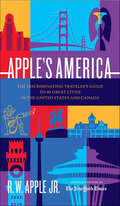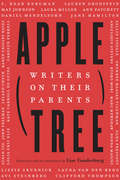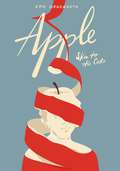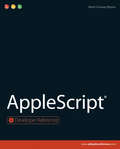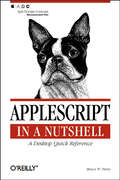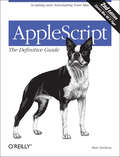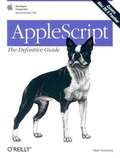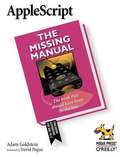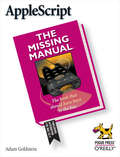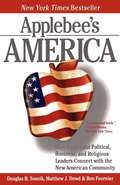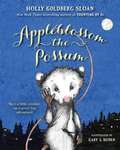- Table View
- List View
Apple's America: The Discriminating Traveler's Guide to 40 Great Cities in the United States and Canada
by R. W. Apple Jr.Unpretentious, sophisticated, and always appetizing advice from a celebrated authorityFor more than thirty years, R. W. Apple Jr. roamed the United States as an eyewitness to history. Here, in Apple's America, his robust enthusiasm for the food and culture of New England, the South and West, the Atlantic and Pacific coasts, and his native Middle West carried him to forty great cities, where he proves to be our ideal guide--amused and amusing, knowledgeable, indefatigable, and endlessly curious.From Boston to Honolulu, from Montreal to Las Vegas, Cincinnati to Seattle, Johnny Apple explores the landmarks, architecture, business, culture, and, of course, the food and beverages of his favorite urban communities. Capturing the tone and style of American city life to perfection, he shows us the hidden treasures, the best buildings, the famous landmarks, the historical aura, and the present-day realities that make each city so memorable. And in each he recommends several places to stay, numerous places to eat, and sites or activities you shouldn't miss. No traveler in the United States will want to do without his recommendations.
Apple's Angst
by Rebecca EcklerApple is back for another story filled with plenty of drama, boys, gossip -- and, of course, angst. Things in Apple's life are slowly getting back to normal: her friendship with Happy seems to have survived her Crazy Girl Moment (i.e. sabotaging Happy's relationship with Zen), she has a new sort of-boyfriend, Lyon (cute and very sweet, but no pitter-patters in her heart), and she's landed a gig interning for Angst magazine (hottest teen magazine around). But, as it usually happens for Apple, life is never this perfect. Just add into the mix a snarky co-worker, an ever-annoying famous talk-show mother, and a major secret crush on her best friend's boyfriend that just won't go away, and things are about to get a lot more complicated . . .From the Trade Paperback edition.
Apple's Core
by Noam WassermanSteve Jobs and Steve Wozniak are best friends who enjoy pulling pranks together and talking about electronics. After several small collaborations, Jobs pitches Wozniak on starting a company together to sell computers based on Wozniak's design for a personal computer. Wozniak faces decisions about whether to quit the job he loves at Hewlett-Packard to join Apple Computer, how to define his role within Apple, whether to take on Jobs as his co-founder, whether to accept a third co-founder proposed by Jobs, and how to split equity with his co-founders. Early on, they add an outside investor who changes the company's trajectory and who brings in a new chief executive. Later, tensions rise between the two founders as their strategic visions diverge and as the company grows. Wozniak has now learned some disturbing news about his co-founder and has to decide whether that news will affect his continuing collaboration with Jobs.
Apple's Core (Graphic Novel Version)
by Noam Wasserman Thomas Alexander<P><P> <i>Advisory: Bookshare has learned that this book offers only partial accessibility. We have kept it in the collection because it is useful for some of our members. Benetech is actively working on projects to improve accessibility issues such as these.</i>
Apple's Future: Apple Watch, Apple TV, and/or Apple Car?
by David B. Yoffie Eric BaldwinIn 2015, Apple CEO Tim Cook knew that Apple, despite its phenomenal success, needed to continue to innovate in new product areas in order to continue its momentum into the future. This case explores three new (actual or potential) product offerings from Apple: the Apple Watch, Apple TV, and the Apple Car. All three categories represented significant opportunities and challenges. The smartwatch category was new and poised for growth when Apple released its Watch in April 2015, but the use case remained uncertain, and Apple would face a strong challenge from Android-based competitors. The television industry, facing growing dissatisfaction with traditional cable packages and the rise of online streaming, was ripe for disruption, but would Apple be able to build a competitive offering? The automotive industry, with the rise of electric cars and autonomous driving technology, was also on the cusp of significant changes, but the engineering and economic challenges of the industry made any move into that space a risky bet.
Apple, Einhorn, and iPrefs
by Carliss Y. Baldwin Hanoch Feit Edward A. Minasian Brandon Van BurenIn March 2013, Apple Inc. has a very large cash balance and is under pressure to return cash to shareholders. Hedge fund manager David Einhorn thinks Apple can "unlock value" by issuing perpetual preferred stock, dubbed iPrefs. Henry Blodget, CEO of The Business Insider, disagrees, saying "you can't just wave your magic wand and make something of nothing." This short case is designed to support a discussion of "perfect" markets and the Modigliani-Miller capital structure irrelevance propositions. The case focuses on two questions: (1) From a shareholder's perspective, how is Apple's cash different from cash in a bank or money market account? (2) Can Apple create significant value for shareholders by splitting each common share into an iPref plus a common share?
Apple, Einhorn, and iPrefs (Abridged)
by Carliss Y. Baldwin W. Carl KesterIn March 2013, Apple Computer has a very large cash balance, and is under pressure to return cash to shareholders. Hedge fund manager David Einhorn thinks Apple can "unlock value" by issuing perpetual preferred stock, dubbed iPrefs. Henry Blodget, CEO of Business Insider, disagrees, saying "you can't just wave your magic wand and make something of nothing." This short case is designed to support a discussion of "perfect" markets and the Modigliani-Miller capital structure irrelevance propositions. The case focuses on two questions: (1) From a shareholder's perspective, how is Apple's cash different from cash in a bank or money market account? (2) Can Apple create significant value for shareholders by splitting each common share into an iPref plus a common share?
Apple, Tree: Writers on Their Parents
by Lise FunderburgIt happens to us all: we think we’ve settled into an identity, a self, and then out of nowhere and with great force, the traces of our parents appear to us, in us—in mirrors, in gestures, in reaction and reactivity, at weddings and funerals, and in troubled thoughts that crouch in dark corners of our minds. In this masterful collection of new essays, the apple looks at the tree. Twenty-five writers deftly explore a trait they’ve inherited from a parent, reflecting on how it affects the lives they lead today—how it shifts their relationship to that parent (sometimes posthumously) and to their sense of self.Apple, Tree’s all-star lineup of writers brings eloquence, integrity, and humor to topics such as arrogance, obsession, psychics, grudges, table manners, luck, and laundry. Contributors include Laura van den Berg, S. Bear Bergman, John Freeman, Jane Hamilton, Mat Johnson, Daniel Mendelsohn, Kyoko Mori, Ann Patchett, and Sallie Tisdale, among others. Together, their pieces form a prismatic meditation on how we make fresh sense of ourselves and our parents when we see the pieces of them that live on in us.
Apple: (Skin to the Core)
by Eric GansworthNational Book Award LonglistTIME's 10 Best YA and Children's Books of 2020NPR's Best Book of 2020Shelf Awareness's Best Books of 2020Publishers Weekly's Big Indie Books of FallAmazon's Best Book of the MonthAICL Best YA Books of 2020CSMCL Best Multicultural Children's Books of 2020PRAISE"Stirring…. Raw and moving." —TIME"Beautiful imagery and with words that soar and scald." —The Buffalo News"Easily one of the best books to be published in 2020. The kind of book bound to save lives." —LitHub"A powerful narrative about identity and belonging." —Paste MagazineFOUR STARRED REVIEWS★ "Timely and important." —Booklist, starred review★ "Searing yet dryly funny." —The Bulletin, starred review★ "Exceptional." —Shelf-Awareness, starred review★ "Captivating." —School Library Journal, starred reviewThe term "Apple" is a slur in Native communities across the country. It's for someone supposedly "red on the outside, white on the inside."In APPLE (SKIN TO THE CORE), Eric Gansworth tells his story, the story of his family—of Onondaga among Tuscaroras—of Native folks everywhere. From the horrible legacy of the government boarding schools, to a boy watching his siblings leave and return and leave again, to a young man fighting to be an artist who balances multiple worlds.Eric shatters that slur and reclaims it in verse and prose and imagery that truly lives up to the word heartbreaking.
Apple: Privacy vs. Safety (A)
by Nien-He Hsieh Henry W. McGee Christian GodwinIn 2015, Apple CEO Tim Cook debuted the iPhone 6S with enhanced security measures that enflamed a debate on privacy and public safety around the world. The iPhone 6S, amid a heightened concern for privacy following the 2013 revelation of clandestine U.S. surveillance programs, employed a default encryption system that prevented both Apple and government authorities from accessing data stored on the device. Law enforcement officials warned that the encryption hindered investigations for criminal cases and international terrorism and called on Apple to build a backdoor, a way to bypass the encryption. But Cook maintained that any backdoor would compromise customers' privacy and security. In 2016, a federal judge ordered Apple to provide technical assistance to unlock the iPhone used by one of the two mass shooters who killed 14 people in San Bernardino, California. Apple refused to comply with the order and asked the government to withdraw its demand. This refusal highlighted Apple's stated policy of supporting consumer privacy. Meanwhile, in China, Apple removed various VPN apps from Apple's Chinese App Store. This action elicited strong negative responses from civil rights activists and members of the U.S. government. In 2019, Apple again faced criticism for removing the HKmap.live app from the App Store, which had been used by protestors in Hong Kong. As these situations unfolded, Cook considered his responsibilities to global governments as well as to Apple's customers, employees, and shareholders.
Apple: Privacy vs. Safety (B)
by Nien-He Hsieh Henry W. McGee Christian GodwinIn 2020, as the COVID-19 pandemic swept across the globe, Apple and Google partnered to develop a contract tracing application that would collect information about users infected with the disease and notify those who they had been in contact with. While Apple/Google's app would keep information about infection and contact private, some governments wanted more access. Apple and Google refused to provide this information, sparking a debate over what responsibilities the companies had in the realms of personal privacy and public health. This incident marked a seeming increase in privacy protections among technology companies, with Apple increasing user privacy options with its iOS 14 update and Zoom offering free end-to-end encryption. Did this indicate a permanent shift in the tension between privacy and safety?
Apple: Privacy vs. Safety? (A)
by Nien-He Hsieh Sarah McAra Henry W. McGeeIn 2015, Apple CEO Tim Cook debuted the iPhone 6S with enhanced security measures that enflamed a debate on privacy and public safety around the world. The iPhone 6S, amid a heightened concern for privacy following the 2013 revelation of clandestine U.S. surveillance programs, employed a default encryption system that prevented both Apple and government authorities from accessing data stored on the device. Law enforcement officials warned that the encryption hindered investigations of criminal cases and international terrorism and called on Apple to build a backdoor, a way to bypass the encryption. But Cook maintained that any backdoor would compromise customers' privacy and security. In 2016, a federal judge ordered Apple to provide technical assistance to unlock the iPhone used by a terrorist who, along with his wife, killed 14 people in San Bernardino, California. Apple refused to comply with the order and asked the government to withdraw its demand. As the court case unfolded, Cook considered his responsibilities to the U.S. government as well as to Apple's customers, employees, and shareholders.
Apple: Privacy vs. Safety? (B)
by Nien-He Hsieh Henry W. McGee Christian GodwinIn 2016 and 2017, Apple refused to help the FBI access the iPhones of two mass shooters. These refusals highlighted Apple's general policy of supporting consumer privacy over public safety. Meanwhile, in China, Apple removed various VPN apps from Apple's Chinese App Store. This action elicited strong negative responses from civil rights activists and members of the U.S. government. In 2019, Apple again faced criticism for removing the HKmap.live app from the App Store, which had been used by protestors in Hong Kong. Other businesses, such as the National Basketball Association (NBA) also faced criticism for their postures toward China.
Apple: Privacy vs. Safety? (B)
by Nien-He Hsieh Henry McGee Nathaniel SchwalbThis case supplements “Apple: Privacy vs. Safety (A), covering select events in 2017, including 1) a mass shooting in which U.S. law enforcement was not able to access the shooter’s encrypted iPhone and 2) Apple’s compliance with the Chinese government’s request to make it more difficult for iPhone users to download “Virtual Private Network” apps.
Apple: Privacy vs. Safety? (B)
by Nien-He Hsieh Nathaniel Schwalb Henry W. McGeeThis case supplements "Apple: Privacy vs. Safety (A), covering select events in 2017, including 1) a mass shooting in which U.S. law enforcement was not able to access the shooter's encrypted iPhone and 2) Apple's compliance with the Chinese government's request to make it more difficult for iPhone users to download "Virtual Private Network" apps.
AppleScript
by Mark Conway MunroDevelopers will advance their AppleScript skills easily with this guidePart of the Developer Reference series, this book is packed with professional secrets for designing and building automated solutions with AppleScript, the powerful, system-level scripting language built into every Mac. Programmers will discover new ways to increase their professional efficiency and become more valuable in their jobs.With up to date coverage of Mac OS X 10.6 Snow Leopard and loaded with real-world tips and techniques, this guide includes best practices and conventions along with informative lessons. You'll advance your scripting skills to the next level under the direction of a long-time veteran of the AppleScript community.Provides step-by-step lessons for designing and building automated solutions with AppleScriptWritten by a well-respected veteran of the AppleScript communityPart of the Developer Reference series that focuses on enhancing the skills of professional Apple developersFilled with professional secrets, tips and techniques to help programmers increase their professional valueIncludes best practices, naming conventions, and much moreWith the information you'll get from AppleScript,you'll become a better and more effective developer.Note: CD-ROM/DVD and other supplementary materials are not included as part of eBook file.
AppleScript in a Nutshell: A Desktop Quick Reference (In a Nutshell (O'Reilly))
by Bruce W. PerryAppleScript in a Nutshell is the first complete reference to AppleScript, the popular programming language that gives both power users and sophisticated enterprise customers the important ability to automate repetitive tasks and customize applications. As the Macintosh continues to expand and solidify its base in the multimedia and publishing industries, AppleScript is the tool of choice on this platform for creating sophisticated time- and money-saving workflow applications (applets). These applets automate the processing and management of digital video, imaging, print, and web-based material. AppleScript is also gaining a foothold in scientific programming, as technical organizations adopt G4 CPU-based systems for advanced computing and scientific analysis. Finally, "power users" and script novices will find that AppleScript is a great everyday Mac programming tool, similar to Perl on Windows NT or Unix.In this well-organized and concise reference, AppleScript programmers will find:Detailed coverage of AppleScript Version 1.4 and beyond on Mac OS 9 and Mac OS X.Complete descriptions of AppleScript language features, such as data types, flow-control statements, functions, object-oriented features (script objects and libraries), and other syntactical elements.Descriptions and hundreds of code samples on programming the various "scriptable" system components, such as the Finder, File Sharing, File Exchange, Network scripting, Web scripting, Apple System Profiler, the ColorSync program, and the numerous powerful language extensions called "osax" or scripting additions.Most other AppleScript books are hopelessly out of date. AppleScript in a Nutshell covers the latest updates and improvements with practical, easy to understand tips, including:Using AppleScript as a tool for distributed computing, an exciting development that Apple Computer calls "program linking over IP." Programmers can now do distributed computing with Macs over TCP/IP networks, including controlling remote applications with AppleScript and calling AppleScript methods on code libraries that are located on other machines.Using the Sherlock find application to automate web and network searching.Insights on scripting new Apple technologies such as Apple Data Detectors, Folder Actions, Keychain Access, and Apple Verifier.AppleScript in a Nutshell is a high-end handbook at a low-end price--an essential desktop reference that puts the full power of this user-friendly programming language into every AppleScript user's hands.
AppleScript: Scripting and Automating Your Mac
by Matt NeuburgMac users everywhere--even those who know nothing about programming--are discovering the value of the latest version of AppleScript, Apple's vastly improved scripting language for Mac OS X Tiger. And with this new edition of the top-selling AppleScript: The Definitive Guide, anyone, regardless of your level of experience, can learn to use AppleScript to make your Mac time more efficient and more enjoyable by automating repetitive tasks, customizing applications, and even controlling complex workflows.Fully revised and updated--and with more and better examples than ever--AppleScript: The Definitive Guide, 2nd Edition explores AppleScript 1.10 from the ground up. You will learn how AppleScript works and how to use it in a variety of contexts: in everyday scripts to process automation, in CGI scripts for developing applications in Cocoa, or in combination with other scripting languages like Perl and Ruby. AppleScript has shipped with every Mac since System 7 in 1991, and its ease of use and English-friendly dialect are highly appealing to most Mac fans. Novices, developers, and everyone in between who wants to know how, where, and why to use AppleScript will find AppleScript: The Definitive Guide, 2nd Edition to be the most complete source on the subject available. It's as perfect for beginners who want to write their first script as it is for experienced users who need a definitive reference close at hand. AppleScript: The Definitive Guide, 2nd Edition begins with a relevant and useful AppleScript overview and then gets quickly to the language itself; when you have a good handle on that, you get to see AppleScript in action, and learn how to put it into action for you. An entirely new chapter shows developers how to make your Mac applications scriptable, and how to give them that Mac OS X look and feel with AppleScript Studio. Thorough appendixes deliver additional tools and resources you won't find anywhere else. Reviewed and approved by Apple, this indispensable guide carries the ADC (Apple Developer Connection) logo.
AppleScript: The Definitive Guide
by Matt NeuburgAppleScript: The Definitive Guide explores and teaches the language from the ground up. If you're a beginner and want to learn how to write your first script or just understand what the excitement is all about, you'll be able to do so after reading this book. Experienced AppleScripters will love having the most definitive, up-to-date AppleScript language reference available.
AppleScript: The Definitive Guide
by Matt NeuburgIf you want to know all about AppleScript--the how, where, and why of using it--dig into AppleScript: The Definitive Guide . It doesn't make the mistake that other books do: it isn't about scripting this or that particular application, and it doesn't assume that learning AppleScript is easy or obvious. Instead, the book teaches and documents the language in a clear and rigorous manner, just as you'd expect with any programming or scripting language. AppleScript is a dynamic, object-oriented scripting system that allows Mac users--even novices who know nothing about programming--to directly control Macintosh applications, including the Mac OS itself. You can write scripts to automate repetitive tasks, customize applications, and even control complex workflows. AppleScript has always been useful, but with Mac OS X it's even more so. Nearly every application that comes with Mac OS X is scriptable. Even non-scriptable applications can often be driven with AppleScript, thanks to the new Accessibility API and GUI Scripting technologies. And now AppleScripters can put a true Aqua interface around their scripts! There's never been a more exciting time for AppleScript users. AppleScript: The Definitive Guide explores and teaches the language from the ground up. If you're a beginner and want to learn how to write your first script or just understand what the excitement is all about, you'll be able to do so after reading this book. AppleScript: The Definitive Guide is the quintessential guide to this important Mac tool. Regardless of their level of experience, AppleScripters everywhere will turn to this book again and again.
AppleScript: The Missing Manual
by Adam GoldsteinFrom newspapers to NASA, Mac users around the world use AppleScript to automate their daily computing routines. Famed for its similarity to English and its ease of integration with other programs, AppleScript is the perfect programming language for time-squeezed Mac fans. As beginners quickly realize, however, AppleScript has one major shortcoming: it comes without a manual. No more. You don't need a degree in computer science, a fancy system administrator title, or even a pocket protector and pair of nerdy glasses to learn the Mac's most popular scripting language; you just need the proper guide at your side. AppleScript: The Missing Manual is that guide. Brilliantly compiled by author Adam Goldstein, AppleScript: The Missing Manual is brimming with useful examples. You'll learn how to clean up your Desktop with a single click, for example, and how to automatically optimize pictures for a website. Along the way, you ll learn the overall grammar of AppleScript, so you can write your own customized scripts when you feel the need. Naturally, AppleScript: The Missing Manual isn't merely for the uninitiated scripter. While its hands-on approach certainly keeps novices from feeling intimidated, this comprehensive guide is also suited for system administrators, web and graphics professionals, musicians, scientists, mathematicians, engineers, and others who need to learn the ins and outs of AppleScript for their daily work. Thanks to AppleScript: The Missing Manual , the path from consumer to seasoned script has never been clearer. Now you, too, can automate your Macintosh in no time.
AppleScript: The Missing Manual
by Adam GoldsteinWritten for the average Mac OS X user, this guide explains how to use the AppleScript language for automating common tasks, such as controlling files, creating lists, organizing a photo library, and playing music. The 16-year-old author also discusses linking scripts to folders, scripting programs that don't have dictionaries, mixing AppleScript and Unix, and debugging scripts. Annotation ©2004 Book News, Inc. , Portland, OR (booknews. com)
AppleScript: The Missing Manual
by Adam GoldsteinFrom newspapers to NASA, Mac users around the world use AppleScript to automate their daily computing routines. Famed for its similarity to English and its ease of integration with other programs, AppleScript is the perfect programming language for time-squeezed Mac fans. As beginners quickly realize, however, AppleScript has one major shortcoming: it comes without a manual.No more. You don't need a degree in computer science, a fancy system administrator title, or even a pocket protector and pair of nerdy glasses to learn the Mac's most popular scripting language; you just need the proper guide at your side. AppleScript: The Missing Manual is that guide.Brilliantly compiled by author Adam Goldstein, AppleScript: The Missing Manual is brimming with useful examples. You'll learn how to clean up your Desktop with a single click, for example, and how to automatically optimize pictures for a website. Along the way, you ll learn the overall grammar of AppleScript, so you can write your own customized scripts when you feel the need.Naturally, AppleScript: The Missing Manual isn't merely for the uninitiated scripter. While its hands-on approach certainly keeps novices from feeling intimidated, this comprehensive guide is also suited for system administrators, web and graphics professionals, musicians, scientists, mathematicians, engineers, and others who need to learn the ins and outs of AppleScript for their daily work.Thanks to AppleScript: The Missing Manual, the path from consumer to seasoned script has never been clearer. Now you, too, can automate your Macintosh in no time.
Applebee's America
by Douglas B. Sosnik Matthew J. Dowd Ron FournierIn this era of technology, terror, and massive social change, it takes a deft touch to connect with Americans. Applebee's America cracks the twenty-first-century code for political, business, and religious leaders struggling to keep pace with the times. A unique team of authors -- Douglas B. Sosnik, a strategist in the Clinton White House; Matthew J. Dowd, a strategist for President Bush's two campaigns; and award-winning political journalist Ron Fournier -- took their exclusive insiders' knowledge far outside Washington's beltway in search of keys to winning leadership. They discovered that successful leaders, even those from disparate fields, have more in common than not. Their book takes you inside the reelection campaigns of Bush and Clinton, behind the scenes of hyper-successful megachurches, and into the boardrooms of corporations such as Applebee's International, the world's largest casual dining restaurant chain. You'll also see America through the anxious eyes of ordinary people, buffeted by change and struggling to maintain control of their lives. Whether you're promoting a candidate, a product, or the Word of God, the rules are the same in Applebee's America. People make choices about politics, consumer goods, and religion with their hearts, not their heads. Successful leaders touch people at a gut level by projecting basic American values that seem lacking in modern institutions and missing from day-to-day life experiences. The most important Gut Values today are community and authenticity. People are desperate to connect with one another and be part of a cause greater than themselves. They're tired of spin and sloganeering from political, business, and religious institutions that constantly fail them. A person's lifestyle choices can be used to predict how he or she will vote, shop, and practice religion. The authors reveal exclusive new details about the best "LifeTargeting" strategies. In this age of skepticism and media diversification, people are abandoning traditional opinion leaders for "Navigators." These otherwise average Americans help their family, friends, neighbors, and coworkers negotiate the swift currents of change in twenty-first-century America. Winning leaders ignore conventional wisdom and its many myths, including these false assumptions: Voters only act in their self-interests; Republicans rule exurbia; and technology drives people apart. Wrong, wrong, and wrong. Once you squander a Gut Values Connection, you may never get it back. Bush learned that hard lesson within a year of winning reelection. Applebee's America offers numerous practical examples of how leaders -- whether from the worlds of politics, business, or religion -- earn the loyalty and support of people by understanding and sharing their values and goals.
Appleblossom the Possum
by Holly Sloan Gary RosenFans of E.B. White and Dick King-Smith will adore this heartwarming and funny animal adventure by the award-winning author of Counting by 7s Mama has trained up her baby possums in the ways of their breed, and now it's time for all of them--even little Appleblossom--to make their way in the world. Appleblossom knows the rules: she must never be seen during the day, and she must avoid cars, humans, and the dreaded hairies (sometimes known as dogs). Even so, Appleblossom decides to spy on a human family--and accidentally falls down their chimney! The curious Appleblossom, her faithful brothers--who launch a hilarious rescue mission--and even the little girl in the house have no idea how fascinating the big world can be. But they're about to find out!With dynamic illustrations, a tight-knit family, and a glimpse at the world from a charming little marsupial's point of view, this cozy animal story is a perfect read-aloud and a classic in the making.
